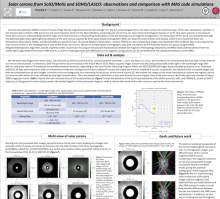Solar corona from SolO/Metis and SOHO/LASCO : observations and comparison with MAS code simulations
Francesco
Frascella
University of Turin/National Institute of Astrophysics
Poster
Understanding how coronal mass ejections (CMEs) originate and evolve is of the uppermost importance for Space Weather as they are one of the most energetic events in our Solar System and may severely impact technological assets (e.g., power grids) and affect human space exploration. In this study, we use data sets of total and polarized broadband visible-light brightness (pB) of the solar K-corona acquired by two space coronagraphs: Metis (on board the Solar Orbiter, SolO) and LASCO-C2 (on board the Solar and Hemispheric Observatory, SOHO). For both instruments, we retrieved data images from December 2021 to the first SolO perihelion in March 2022. From these data sets, we derived a side-by-side temporal sequence, showing the evolution of the solar corona and the occurrence of several CMEs as seen from the two different lines of sight.
Starting from these preliminary results, we aim at performing a comparison with
simulations derived from the MAS (Magnetohydrodynamic Algorithm outside a Sphere) model developed by the Predictive Science Inc. group. This model is frequently used, for instance, to forecast the magnetic structures of the solar corona during total solar eclipses. In particular, we aim at comparing the magnetic-field topology derived from the MAS model with the magnetic configuration that can be inferred from the visible-light images before the
onset of the CMEs events. The goal is to investigate how possible differences between those magnetic configurations could be correlated with the subsequent CMEs evolution.
Starting from these preliminary results, we aim at performing a comparison with
simulations derived from the MAS (Magnetohydrodynamic Algorithm outside a Sphere) model developed by the Predictive Science Inc. group. This model is frequently used, for instance, to forecast the magnetic structures of the solar corona during total solar eclipses. In particular, we aim at comparing the magnetic-field topology derived from the MAS model with the magnetic configuration that can be inferred from the visible-light images before the
onset of the CMEs events. The goal is to investigate how possible differences between those magnetic configurations could be correlated with the subsequent CMEs evolution.

Poster PDF
Poster category
Solar and Interplanetary Research and Applications
Meeting homepage